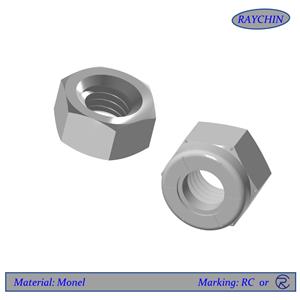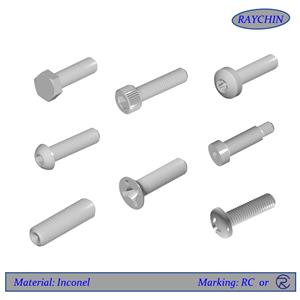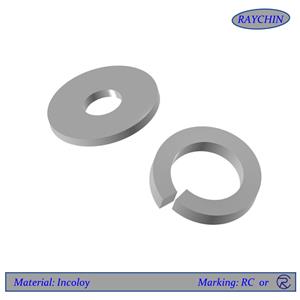Special metal fasteners - Inconel fasteners
Special metal fasteners - Inconel fasteners, Bolts, Nuts, Screws, Washers
Inconel is a registered trademark of Special Metals Corporation for a family of austenitic nickel-chromium-based superalloys.
Inconel alloys are oxidation-corrosion-resistant materials well suited for service in extreme environments subjected to pressure and heat. When heated, Inconel forms a thick, stable, passivating oxide layer protecting the surface from further attack. Inconel retains strength over a wide temperature range, attractive for high-temperature applications where aluminum and steel would succumb to creep as a result of thermally induced crystal vacancies. Inconel's high-temperature strength is developed by solid solution strengthening or precipitation hardening, depending on the alloy.
Inconel is a registered trademark of Special Metals Corporation for a family of austenitic nickel-chromium-based superalloys.
Inconel alloys are oxidation-corrosion-resistant materials well suited for service in extreme environments subjected to pressure and heat. When heated, Inconel forms a thick, stable, passivating oxide layer protecting the surface from further attack. Inconel retains strength over a wide temperature range, attractive for high-temperature applications where aluminum and steel would succumb to creep as a result of thermally induced crystal vacancies. Inconel's high-temperature strength is developed by solid solution strengthening or precipitation hardening, depending on the alloy.
Inconel alloys are typically used in high temperature applications. Common trade names for
Inconel Alloy 625 include: Inconel 625, Chronin 625, Altemp 625, Haynes 625, Nickelvac 625 and Nicrofer 6020.
Inconel Alloy 600 include: NA14, N06600, BS3076, 2.4816, NiCr15Fe (FR), NiCr15Fe (EU) and NiCr15Fe8 (DE).
Inconel 718 include: Nicrofer 5219, Superimphy 718, Haynes 718, Pyromet 718, Supermet 718, and Udimet 718.
Composition:
Inconel alloys vary widely in their compositions, but all are predominantly nickel, with chromium as the second element.

Properties:
Inconel alloys are oxidation- and corrosion-resistant materials well suited for service in extreme environments subjected to high mechanical loads. When heated, Inconel forms a thick and stable passivating oxide layer protecting the surface from further attack. Inconel retains strength over a wide temperature range, attractive for high-temperature applications where aluminium and steel would succumb to creep as a result of thermally induced crystal vacancies (see Arrhenius equation). Inconel's high temperature strength is developed by solid solution strengthening or precipitation strengthening, depending on the alloy. In age-hardening or precipitation-strengthening varieties, small amounts of niobium combine with nickel to form the intermetallic compound Ni3Nb or gamma double prime (γ″). Gamma prime forms small cubic crystals that inhibit slip and creep effectively at elevated temperatures. The formation of gamma-prime crystals increases over time, especially after three hours of a heat exposure of 850 °C (1,560 °F), and continues to grow after 72 hours of exposure.
Machining:
Inconel is a difficult metal to shape and to machine using traditional cold forming techniques due to rapid work hardening. After the first machining pass, work hardening tends to plastically deform either the workpiece or the tool on subsequent passes. For this reason, age-hardened Inconels such as 718 are machined using an aggressive but slow cut with a hard tool, minimizing the number of passes required. Alternatively, the majority of the machining can be performed with the workpiece in a "solutionized" form, with only the final steps being performed after age hardening.
External threads are machined using a lathe to "single-point" the threads or by rolling the threads in the solution treated condition (for hardenable alloys) using a screw machine. Inconel 718 can also be roll-threaded after full aging by using induction heat to 700 °C (1,290 °F) without increasing the grain size.[citation needed] Holes with internal threads are made by threadmilling. Internal threads can also be formed using a sinker electrical discharge machining (EDM).
Cutting of a plate is often done with a waterjet cutter. New whisker-reinforced ceramic cutters are also used to machine nickel alloys. They remove material at a rate typically eight times faster than cemented carbide cutters. Apart from these methods, Inconel parts can also be manufactured by selective laser melting and electrochemical machining.
More often than machining, water-jet or laser grinding is a preferred and economical method for forming nickel alloy components to shape and finish. Due to the hardness of the abrasives used, the grinding wheels are not as affected by the material work hardening and remain sharp and durable.
Uses:
Inconel is often encountered in extreme environments. It is common in gas turbine blades, seals, and combustors, as well as turbocharger rotors and seals, electric submersible well pump motor shafts, high temperature fasteners, chemical processing and pressure vessels, heat exchanger tubing, steam generators and core components in nuclear pressurized water reactors, natural gas processing with contaminants such as H2S and CO2, firearm sound suppressor blast baffles, and Formula One, NASCAR, NHRA, and APR, LLC exhaust systems. It is also used in the turbo system of the 3rd generation Mazda RX7, and the exhaust systems of high powered Wankel engined Norton motorcycles where exhaust temperatures reach more than 1,000 °C (1,830 °F). Inconel is increasingly used in the boilers of waste incinerators. The Joint European Torus and DIII-D tokamaks' vacuum vessels are made of Inconel. Inconel 718 is commonly used for cryogenic storage tanks, downhole shafts and wellhead parts.
Several applications of inconel in aerospace include:
The Space Shuttle used four Inconel studs to secure the solid rocket boosters to the launch platform, eight total studs supported the entire weight of the ready to fly Shuttle system. Eight frangible nuts are encased on the outside of the solid rocket boosters, at launch explosives separated the nuts releasing the Shuttle from its launch platform.
North American Aviation constructed the skin of the North American X-15 Rocket-powered aircraft out of an Inconel alloy.
Rocketdyne used Inconel X-750 for the thrust chamber of the F-1 rocket engine used in the first stage of the Saturn V booster.
SpaceX uses inconel (Inconel 718) in the engine manifold of their Merlin engine which powers the Falcon 9 launch vehicle.
In a first for 3D printing, the SpaceX SuperDraco rocket engine that provides launch escape system for the Dragon V2 crew-carrying space capsule is fully printed. In particular, the engine combustion chamber is printed of Inconel using a process of direct metal laser sintering, and operates at very high temperature and a chamber pressure of 6.9 megapascals (1,000 psi).
SpaceX cast the Raptor rocket engine manifolds from SX300 later SX500 which are monocrystal nickel alloy (improvement over older Inconel alloys).
Inconel is also used in the automotive industry:
Tesla uses Inconel in place of steel in the main battery pack contactor of its Model S so that it remains springy under the heat of heavy current. Tesla claims that this allows these upgraded vehicles to safely increase the maximum pack output from 1300 to 1500 amperes, allowing for an increase in power output (acceleration) Tesla refers to as "Ludicrous Mode".
Ford Motor Company is using Inconel to make the turbine wheel in the turbocharger of its EcoBlue diesel engines introduced in 2016.
The exhaust valves on NHRA Top Fuel and Funny Car drag racing engines are made of Inconel.[citation needed] Inconel is also used in the manufacture of exhaust valves in high performance aftermarket turbo and Supercharged Mazda Miata engine builds (see Flyin' Miata).
Ford Australia used Inconel valves in their turbocharged Barra engines. These valves have been proven very reliable, holding in excess of 1900 horsepower.
BMW has since used Inconel in the exhaust manifold of its high performance luxury car, the BMW M5 E34 with the iconic S38 engine, withstanding higher temperatures and reducing backpressure.[citation needed]
Jaguar Cars has fit, in their Jaguar F-Type SVR high performance sports car, a new lightweight Inconel titanium exhaust system as standard which withstands higher peak temperatures, reduces backpressure and eliminates 16 kg (35 lb) of mass from the vehicle.
Rolled Inconel was frequently used as the recording medium by engraving in black box recorders on aircraft.
Alternatives to the use of Inconel in chemical applications such as scrubbers, columns, reactors, and pipes are Hastelloy, perfluoroalkoxy (PFA) lined carbon steel or fiber reinforced plastic.




